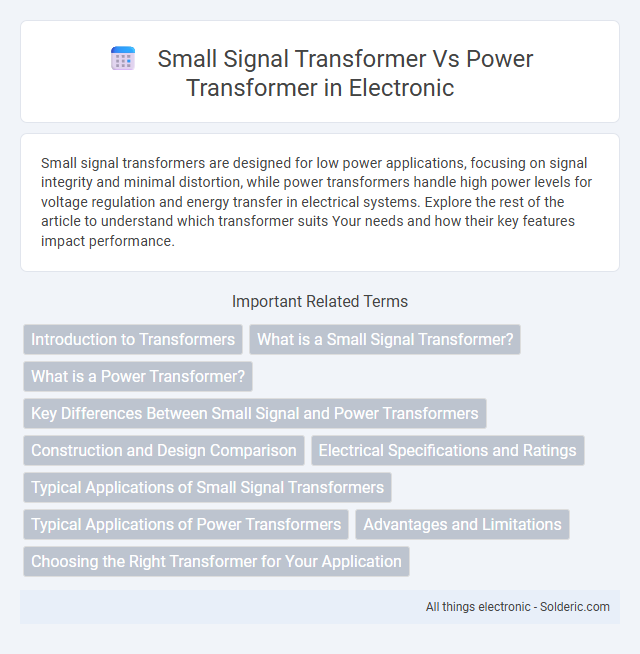Small signal transformers are designed for low power applications, focusing on signal integrity and minimal distortion, while power transformers handle high power levels for voltage regulation and energy transfer in electrical systems. Explore the rest of the article to understand which transformer suits Your needs and how their key features impact performance.
Comparison Table
| Feature | Small Signal Transformer | Power Transformer |
|---|---|---|
| Purpose | Signal level voltage transformation | High power voltage transformation |
| Power Rating | Millivolt to a few watts | Kilowatts to megawatts |
| Size | Compact, miniature design | Large, heavy construction |
| Frequency Range | Wide frequency, audio to RF | Typically 50Hz to 60Hz (power grid) |
| Core Material | Ferrite or laminated steel for low losses | Laminated silicon steel for high efficiency |
| Winding | Fine wire, few turns | Thicker wire, many turns |
| Applications | Audio equipment, instrumentation | Power distribution, industrial use |
| Insulation | Light insulation for low voltages | Robust insulation for high voltages |
Introduction to Transformers
Small signal transformers are designed to handle low power levels and primarily focus on signal isolation and impedance matching in electronic circuits, whereas power transformers manage high power transmission and distribution in electrical systems. Their core materials and winding configurations differ to optimize performance for their specific functions, with small signal transformers emphasizing frequency response and minimal signal distortion. Understanding these distinctions helps you select the right transformer for your application, ensuring efficiency and signal integrity.
What is a Small Signal Transformer?
A small signal transformer is designed to operate at low power levels, typically used for signal processing and impedance matching in audio, communication, and instrumentation circuits. It features a high-frequency response and minimal core losses to accurately transfer low-level electrical signals without distortion. Unlike power transformers, small signal transformers prioritize precision and signal integrity over power handling capacity.
What is a Power Transformer?
A power transformer is an electrical device designed to transfer high voltage electrical energy between circuits while maintaining efficient energy conversion and minimal losses. Primarily used in power distribution networks, it handles large currents and voltages, often ranging from a few kilovolt-amperes (kVA) to several mega volt-amperes (MVA). Their robust construction and enhanced insulation enable them to operate continuously under heavy load conditions, distinguishing them from small signal transformers used in low-power applications.
Key Differences Between Small Signal and Power Transformers
Small signal transformers handle low power levels and high frequencies, primarily used in signal processing and audio applications, while power transformers manage high power for voltage conversion in electrical distribution and industrial settings. Small signal transformers have fewer turns and lighter cores to minimize distortion and noise, whereas power transformers feature robust cores and windings designed to handle heavy electrical loads efficiently. Your choice depends on whether you need precise signal integrity or reliable high-power transfer.
Construction and Design Comparison
Small signal transformers feature finer wire windings and high-permeability cores designed for minimal signal distortion and low power handling, optimizing them for audio or communication circuits. Power transformers employ thicker wire, robust insulation, and laminated steel cores to handle high currents and voltages efficiently while minimizing core losses and heat generation. Your choice depends on the application's voltage, current requirements, and sensitivity to signal integrity.
Electrical Specifications and Ratings
Small signal transformers typically operate at lower power ratings, often below a few watts, with voltage ratings designed for signal-level currents and minimal core losses to preserve signal integrity. Power transformers are rated for higher currents and voltages, often in the kilowatt range, featuring robust insulation, higher thermal limits, and core materials optimized to handle significant power loads without saturation. Electrical specifications for small signal transformers emphasize low leakage inductance and capacitance for high-frequency performance, whereas power transformers focus on efficiency, voltage regulation, and thermal management under heavy load conditions.
Typical Applications of Small Signal Transformers
Small signal transformers are primarily used in electronic circuits for signal processing, impedance matching, and isolation in communication devices, audio equipment, and instrumentation. Unlike power transformers that handle high voltage and current for power distribution, small signal transformers manage low power levels, ensuring minimal signal distortion and high fidelity. Your devices benefit from these transformers' ability to provide precise voltage transformation and noise reduction in sensitive applications.
Typical Applications of Power Transformers
Power transformers are typically used in electrical power generation, transmission, and distribution systems to step up or step down voltage levels for efficient energy transfer across long distances. They are essential in substations to regulate voltage for industrial, commercial, and residential applications, ensuring stable electricity supply. Compared to small signal transformers, power transformers handle significantly higher voltages and currents, supporting large-scale electrical infrastructure.
Advantages and Limitations
Small signal transformers offer advantages such as high-frequency response, low core loss, and precise signal isolation, making them ideal for audio, telecommunications, and instrumentation applications. However, they are limited by lower power handling capacity and less robust construction compared to power transformers, which are designed to manage high voltages and currents efficiently. Power transformers excel in durability and energy transfer efficiency for electrical grids and industrial systems but suffer from larger size, higher cost, and greater core losses at low frequencies.
Choosing the Right Transformer for Your Application
Selecting the appropriate transformer depends on the application's voltage and current requirements, with small signal transformers designed for low power, high-frequency signals and precise impedance matching in electronics. Power transformers handle higher voltages and current loads, providing efficient energy transfer for industrial and electrical distribution systems. Understanding factors such as power rating, frequency range, and isolation needs ensures optimal performance and longevity in your specific use case.
small signal transformer vs power transformer Infographic

 solderic.com
solderic.com